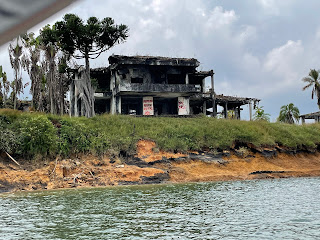After a nice breakfast at this fancier than usual hotel, we set out by bus for the village of Gautapé (gau-tah-pay), a tourist town on the shore of the Embalse Del Peñol (Reservoir of Peñol -- pronounced pen-yol). The reservoir was created in the 1970s by construction of the Gautapé Hydroelectric Dam.
At a rest stop along the way, we drank cocoa and at pan de queso or cheese bread. The cocoa is bitter dark chocolate sweeter heavily with cane sugar. The cheese bread is a round roll, looking somewhat like a bagel.
We got an up-close lesson in how the cheese bread is made at this busy roadside location. The one baker makes up to 2,000 rolls sold here on a typical Saturday.
The rest stop was also selling cow hides, which locals use for upholstery. There was a wide selection of hides available at the gift shop. Fortunately, no one from our group wanted to take one home.
Just before reaching Gautapé, we stopped at a marina that could have been on the shore of any large lake in the U.S. and took a ride on a pontoon boat. From the boat, we viewed Piedra del Peñol (the stone of Peñol), a volcanic pillar rising more than 700 feet above the lake level.
We also viewed the burned out ruins of an expensive lake home once owned by the notorious drug lord, Pablo Escobar. Escobar was nowhere near here when the home was raided by "vigilantes" (who were in reality extrajudicial government police) attempting to pressure Escobar by destroying his assets, prior to his death in 1993 in a shoot-out with police, military, and para-military forces.
Following the boat ride, we entered the town and had a tug-tuk ride through the narrow cobblestone streets. A key attraction of Gautapé are the zócalos (three-dimensional murals) that adorn the lower portions of the houses and businesses here. The tuk-tuks were a great way to see many of these.
The zócalos represent the type of business or attributes of the families in each location. A bakery has baking scenes, a shoe repair shop shows a shoemaker. Families that have been in the area for many generations, before the tourist influx, often show sheep or llamas.
We actually had the opportunity to meet one of the primary artists who makes his living creating zócalos. His nickname (just like the florist we met yesterday) is Nacho. However, his works are always signed Nachos -- plural -- because his two sons now work with him in the business of creating and maintaining this art.
The tuk-tuks dropped us at a restaurant on the main square where we had one of the worst meals of the trip. Mary's fish was OK, but the steak was all gristle. At least the beer, a locally brewed stout, was good.
We had a bit of free time in the town before meeting the bus and taking the two hour trip back to our hotel. The hotel is attached to a gigantic, new, upscale shopping mall. So, we spent some time in the evening strolling in the mall while rain fell outside. The crowd was amazing! There were literally thousands of people, of all ages, walking the mall. Many were walking their dogs, as well. The restaurants and food courts were full. It was the place to be in Medellin on Saturday night.
Tomorrow we fly to a rural agricultural area where we are told that internet connections may be spotty. Posts will be as we are able.











No comments:
Post a Comment